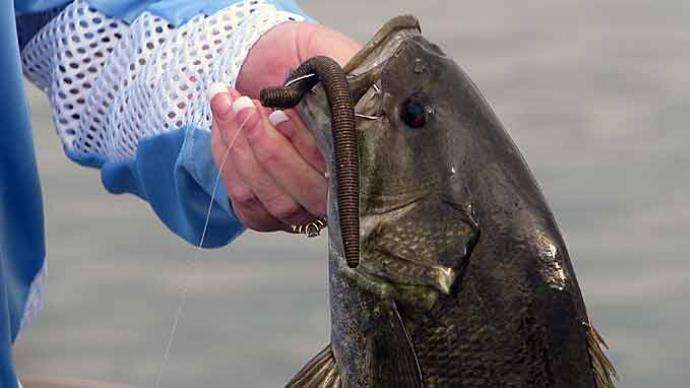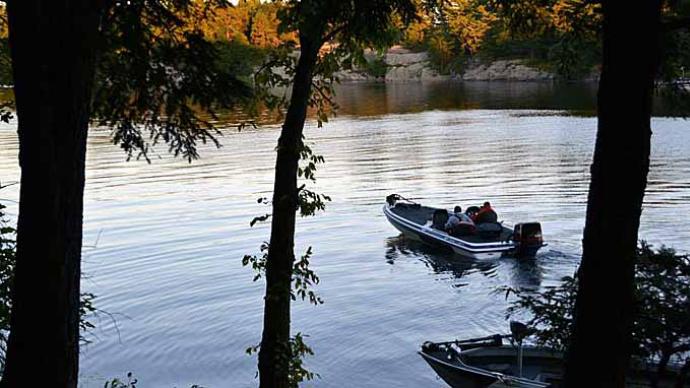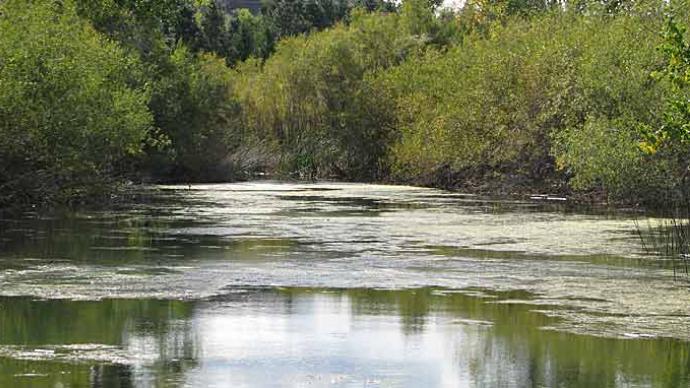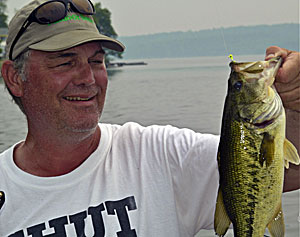
Fishing a new lake or river can be intimidating. Where do you start? Here are five can't-miss locations that will have you hoisting bass over the gunnels in no time.
1. Vegetation - Vegetation or weeds always attract bass. Weeds often represent the dinner table for bass. Vegetation is home to aquatic insects, panfish, minnows, and crayfish that bass feed on. Since a lot of a bass' prime forage lives in the weeds, it's only natural that you'd expect to find bass close by. Bass may live in the weeds, or later in the summer, they may migrate into the vegetation to feed on deeper, cooler water. Feeding bass may take up stations under the floating weeds or patrol a weed line in marauding packs.
Weeds can take two forms – vertical or horizontal. Horizontal weeds, like mats of hydrilla, milfoil, hyacinth, or lily pads, provide excellent overhead cover and protection from the sun and predators above like birds. "Bass love lily pads," offered bass aficionado, Dan Kimmel. "I never go by a group of pads without making a few casts, particularly for largemouth. Sometimes you'll be amazed how many bass can be sitting under one group of pads." Some weeds are rooted to the shoreline and grow several feet away from the shore. The floating mats provide cover in shallow water. Others are rooted to the bottom in deeper water and extend to the surface as summer approaches to create a shaded oasis.
Vertical weeds, like coontail, cabbage, pondweed, and cattails, produce well-defined edges that bass hunt along or indentations where bass can wait in ambush. Bass can be located at the base of vertical weeds or positioned in open pockets within or on top of the weeds if they don't reach the surface. Usually, there's a finite weed line where the weeds end and deeper water begins. Bass may stage out over open water and then migrate to the weeds to feed.
Fishing weeds provide unique challenges. Various weed-less lures will coax bass from the weeds, including Texas-rigged worms, tubes, weedless spoons, a jig-n-pig, rats, buzzbaits, spinnerbaits, and more. Finding what the bass want and the preferred presentation is critical.
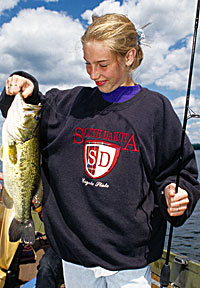
2. “Wood is a magnet for bass,” Kimmel said. "Wood attracts food, and it's an object that bass can relate to. Wood fishes best if there's not a lot of it. Less wood concentrates the fish around what wood is available." Standing timber attracts bass, but horizontal wood is better, like laydowns in which bass can take up residence just like weed mats. Laydowns and other horizontal wood provide overhead cover and shadows for foraging bass and serve as ambush areas. Laydowns that lie perpendicular to shore are best. Bass can position at the very end of laydowns closer to deeper water, or they can position at the shallow end of the wood near weeds where prey may be hiding. Older laydowns are best because they give bass time to find them, and as limbs break off or the tree begins to sink, it becomes less visible to other anglers. Newly fallen trees may look good, but they attract a lot of attention, and it takes a while for bass to find and utilize them.
Laydowns attract a lot of attention. Stumps and limbs that extend above the water are prominent places to target. The inclination by anglers is to use heavy line and tackle to prevent losing baits. However, you may do much better using lighter tackle and line to fool pressured bass.
In some northern lakes, woods structure can take the form of cast-off planks or boards from the lumber industry. Any wood is good because it becomes covered with algae and plankton baitfish feed on, which attracts bass, but the old lumber can be even better if it is stacked rather than lying flat on the bottom. Cribs made to direct and funnel logs during the lumbering era can be hotspots for bass, also.
Stumps are great big-bass cover, especially if the stumps are below the surface and visible only on electronics. Stumps are most commonly found in reservoirs and are common in areas that have been clear-cut before the reservoir was flooded. However, stumps are not exclusive to reservoirs and can also be found in natural lakes. Again, fewer stumps make those that are available prime habitat.
Not all stumps are created equal. How good a stump is for bass depends on where it is located. Is it on a flat or close to a river channel? Does it have a lot of mass and roots? How much water is it in? Catch a fish from one and look at the stump's characteristics, and you may be able to determine what other stumps might hold fish from among a field of hundreds.
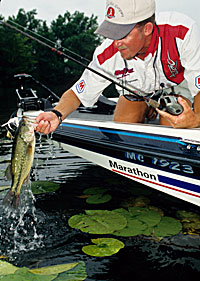
3. Bridges - "Bridges are great spots because they narrow down the waterway, create and funnel current and provide a different type of cover and structure," said Kimmel. "Bridges attract a lot of food sources, too, and it's a constriction area. Bass don't have to hunt near bridges; the food comes to them."
Bridges present a special kind of structure. Bridges are generally deeper on the front side and shallower behind. There's usually a shallow bar on the downstream side that bass may move up on to feed and get out of the current, especially if there's a tree or other debris. Bass may also position on ledges on the bridge abutment. There can be shelves at 10, 20, or 30 feet intervals where the base of the bridge is in 50 feet of water. Bass will stack up on these ledges.
Bridges often have other "special" structures, such as shopping carts, refrigerators, and someone's bike. "I know one bridge with an old shopping cart off of it that I could catch a few bass off of every time I fished it," claimed Kimmel. "Eventually, the current moved it or something, and the fish went with it."
4. Points - Points are classic bass structures, but not all points are created equal. It depends on the main lake points or secondary points and what's on them. Is there gravel, boulders, grass, and wood, or are they relatively clean? Main lake points tend to be used more in the summer and winter, assuming you're not in a place where you can't walk on water come January. Points with steep, quick drop-offs are used more in the summer. Long, tapering secondary points are more productive in the spring and fall. Bass will use them in the spring to spawn and in the fall to feed. Any point can be made better if it has quick access to deep water, some structure in the form of stumps or trees, vegetation or rocks on it, and, more importantly, forage.
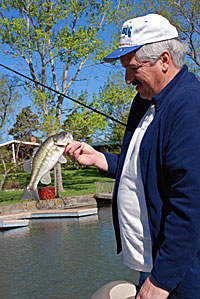
Wind and current can determine how productive a point is, too. Wind can push baitfish schools into the shallows, and cloud water, so crayfish come out of hiding and stir the water to make it easier for bass to forage. The key to fishing points under such conditions is not to fish the calm, more comfortable side of the point but snug down the rain suit and work the rough water.
5. Docks - Docks are an obvious structure that bass relate to, but not all docks are created equal. Bass use docks for cover and a place to ambush prey. Docks close to the water and with large wood pilings are best because they provide the most shade and ambush points. Always fish the shaded side of the dock first. Floating docks can hold fish at times, but they generally are not nearly as productive as docks supported by large wood pilings.
The best docks start shallow and end at the edge of a drop-off in 8 or 10 feet of water. Bass easily access the dock and can migrate from deeper to shallow water without moving very far. Docks that have vegetation near them or brush piles are best. The brush and weeds give baitfish and bass a place to hide. Docks over a clean, sandy bottom don’t like to hold much fish except around the spawn and after dark.
Three things to look for when prospecting docks are their proximity to deep water, if there’s vegetation under the docks or nearby, and how much shade it provides. Another consideration when dock fishing is the shape of the dock. L- and T-shaped docks provide more shade, pilings, nooks, and crannies for bass to use. Even better is if they have a canopy on them. When prospecting docks, note the ones you catch fish near and then try to look for other docks with similar characteristics. Isolated docks will generally hold the biggest numbers of bass.
Casting accurately is a significant advantage when fishing docks. Casting close to pilings or skipping lures underneath the docks is key to extracting the bass that live there.


